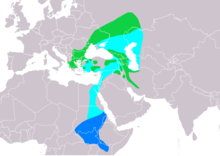Kurzfangsperber
| Kurzfangsperber | ||||||||||
|---|---|---|---|---|---|---|---|---|---|---|

Kurzfangsperber ( Accipiter brevipes ) |
||||||||||
| Systematics | ||||||||||
|
||||||||||
| Scientific name | ||||||||||
| Accipiter brevipes | ||||||||||
| ( Severtzov , 1850) |
The Kurzfangsperber ( Accipiter brevipes ) belongs to the family of the hawk-like (Accipitridae). The species is largely unexplored. In Central Europe, the short-catched curb is only found in eastern Hungary, where a maximum of five breeding pairs currently breed.
Appearance
It is about 30 to 40 centimeters long and reaches spans of up to 80 centimeters. The underside of the birds is almost white in the male, interspersed with transverse bands in the female. Compared to the sparrowhawk, it is slimmer, has more pointed wings with black tips and a shorter tail.
distribution and habitat
It is sparse in south-eastern Europe, most of them live in a strip north of the Black to the Caspian Sea in the east. A maximum of four breeding pairs breed in Hungary, which is why the short-caught sparrowhawk is occasionally included in the avifauna of Central Europe .
Short-catched sparrowhawks are distinct migratory birds and migrate to their winter quarters in September, which may be in southern Sudan , Niger , Chad , Abyssinia or the Arabian Peninsula .
He lives mainly in areas wooded with deciduous trees; preferably in a hilly, varied landscape.
nutrition
They mostly feed on small mammals, lizards and insects, and more rarely on birds. In the twilight, the short-caught sparrowhawk also hunts for bats. The search flight is similar to consecration. During his foraging flights he haws particularly often at the edges of forests and towns.
Reproduction
Short-tailed corsairs reached sexual maturity in their first year of life. They have a monogamous seasonal marriage.
The eyrie is built in deciduous trees, oaks are preferred. The nest is built mainly by the female. Usually the clutch consists of three to five eggs, which are laid from May to the end of June. The eggs are broadly oval, pale bluish to greenish or gray. The breeding period is 29 to 31 days, with only the female breeding. The nestlings can fledge at around forty to 45 days. They remain near the nest for about 15 days after they have fled out.
Duration
The European breeding population is estimated at 3,200 to 7,700 breeding pairs, which corresponds to between 75 and 94 percent of the world population. The European distribution center is Russia, where between 1,500 and 3,000 breeding pairs breed. There are between 1,000 and 2,000 breeding pairs in Greece, between 100 and 1,000 breeding pairs in Azerbaijan and 300 to 900 breeding pairs in Turkey.
supporting documents
literature
- Hans-Günther Bauer, Einhard Bezzel and Wolfgang Fiedler (eds.): The compendium of birds in Central Europe: Everything about biology, endangerment and protection. Volume 1: Nonpasseriformes - non-sparrow birds. Aula-Verlag Wiebelsheim, Wiesbaden 2005, ISBN 3-89104-647-2 .
- Benny Génsbol, Walther Thiede; Birds of prey - All European species, characteristics, flight images, biology, distribution, endangerment, population development , BLV Verlag Munich, 1997, ISBN 3-405-14386-1
- Theodor Mebs ; Birds of prey in Europe - biology - population conditions - population threat Franckh-Kosmos Verlag Stuttgart 2002, ISBN 3-440-06838-2
Web links
- Accipiter brevipes in the endangered Red List species the IUCN 2008. Posted by: BirdLife International, 2008. Accessed January 18 of 2009.
Single receipts
- ^ Walter Thiede: Birds of Prey and Owls - Recognize and identify all species of Central Europe , BLV Buchverlag, Munich 2008, ISBN 978-3-8354-0448-9 , p. 40
- ^ Walter Thiede: Birds of Prey and Owls - Recognize and identify all species of Central Europe , BLV Buchverlag, Munich 2008, ISBN 978-3-8354-0448-9 , p. 40
- ↑ Bauer et al., P. 333

